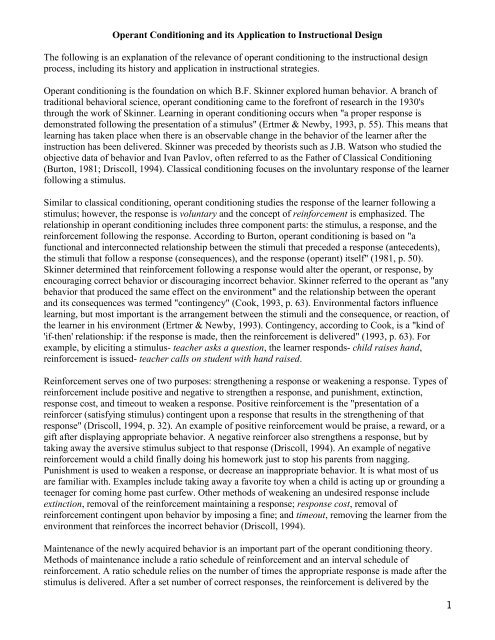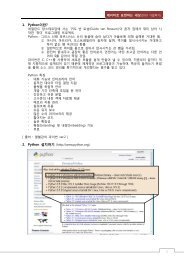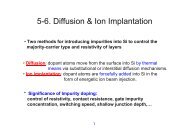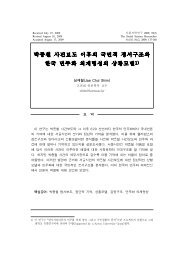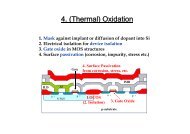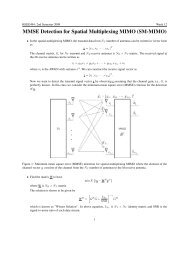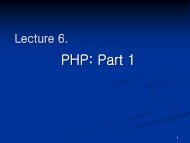Operant Conditioning and its Application to Instructional Design
Operant Conditioning and its Application to Instructional Design
Operant Conditioning and its Application to Instructional Design
You also want an ePaper? Increase the reach of your titles
YUMPU automatically turns print PDFs into web optimized ePapers that Google loves.
<strong>Operant</strong> <strong>Conditioning</strong> <strong>and</strong> <strong>its</strong> <strong>Application</strong> <strong>to</strong> <strong>Instructional</strong> <strong>Design</strong><br />
The following is an explanation of the relevance of operant conditioning <strong>to</strong> the instructional design<br />
process, including <strong>its</strong> his<strong>to</strong>ry <strong>and</strong> application in instructional strategies.<br />
<strong>Operant</strong> conditioning is the foundation on which B.F. Skinner explored human behavior. A branch of<br />
traditional behavioral science, operant conditioning came <strong>to</strong> the forefront of research in the 1930's<br />
through the work of Skinner. Learning in operant conditioning occurs when "a proper response is<br />
demonstrated following the presentation of a stimulus" (Ertmer & Newby, 1993, p. 55). This means that<br />
learning has taken place when there is an observable change in the behavior of the learner after the<br />
instruction has been delivered. Skinner was preceded by theorists such as J.B. Watson who studied the<br />
objective data of behavior <strong>and</strong> Ivan Pavlov, often referred <strong>to</strong> as the Father of Classical <strong>Conditioning</strong><br />
(Bur<strong>to</strong>n, 1981; Driscoll, 1994). Classical conditioning focuses on the involuntary response of the learner<br />
following a stimulus.<br />
Similar <strong>to</strong> classical conditioning, operant conditioning studies the response of the learner following a<br />
stimulus; however, the response is voluntary <strong>and</strong> the concept of reinforcement is emphasized. The<br />
relationship in operant conditioning includes three component parts: the stimulus, a response, <strong>and</strong> the<br />
reinforcement following the response. According <strong>to</strong> Bur<strong>to</strong>n, operant conditioning is based on "a<br />
functional <strong>and</strong> interconnected relationship between the stimuli that preceded a response (antecedents),<br />
the stimuli that follow a response (consequences), <strong>and</strong> the response (operant) <strong>its</strong>elf" (1981, p. 50).<br />
Skinner determined that reinforcement following a response would alter the operant, or response, by<br />
encouraging correct behavior or discouraging incorrect behavior. Skinner referred <strong>to</strong> the operant as "any<br />
behavior that produced the same effect on the environment" <strong>and</strong> the relationship between the operant<br />
<strong>and</strong> <strong>its</strong> consequences was termed "contingency" (Cook, 1993, p. 63). Environmental fac<strong>to</strong>rs influence<br />
learning, but most important is the arrangement between the stimuli <strong>and</strong> the consequence, or reaction, of<br />
the learner in his environment (Ertmer & Newby, 1993). Contingency, according <strong>to</strong> Cook, is a "kind of<br />
'if-then' relationship: if the response is made, then the reinforcement is delivered" (1993, p. 63). For<br />
example, by eliciting a stimulus- teacher asks a question, the learner responds- child raises h<strong>and</strong>,<br />
reinforcement is issued- teacher calls on student with h<strong>and</strong> raised.<br />
Reinforcement serves one of two purposes: strengthening a response or weakening a response. Types of<br />
reinforcement include positive <strong>and</strong> negative <strong>to</strong> strengthen a response, <strong>and</strong> punishment, extinction,<br />
response cost, <strong>and</strong> timeout <strong>to</strong> weaken a response. Positive reinforcement is the "presentation of a<br />
reinforcer (satisfying stimulus) contingent upon a response that results in the strengthening of that<br />
response" (Driscoll, 1994, p. 32). An example of positive reinforcement would be praise, a reward, or a<br />
gift after displaying appropriate behavior. A negative reinforcer also strengthens a response, but by<br />
taking away the aversive stimulus subject <strong>to</strong> that response (Driscoll, 1994). An example of negative<br />
reinforcement would a child finally doing his homework just <strong>to</strong> s<strong>to</strong>p his parents from nagging.<br />
Punishment is used <strong>to</strong> weaken a response, or decrease an inappropriate behavior. It is what most of us<br />
are familiar with. Examples include taking away a favorite <strong>to</strong>y when a child is acting up or grounding a<br />
teenager for coming home past curfew. Other methods of weakening an undesired response include<br />
extinction, removal of the reinforcement maintaining a response; response cost, removal of<br />
reinforcement contingent upon behavior by imposing a fine; <strong>and</strong> timeout, removing the learner from the<br />
environment that reinforces the incorrect behavior (Driscoll, 1994).<br />
Maintenance of the newly acquired behavior is an important part of the operant conditioning theory.<br />
Methods of maintenance include a ratio schedule of reinforcement <strong>and</strong> an interval schedule of<br />
reinforcement. A ratio schedule relies on the number of times the appropriate response is made after the<br />
stimulus is delivered. After a set number of correct responses, the reinforcement is delivered by the<br />
1
instruc<strong>to</strong>r (Driscoll, 1994). Interval scheduling depends on a set amount of time under which the correct<br />
answer is given before reinforcement will be delivered. Both ratio <strong>and</strong> interval scheduling can be<br />
delivered under fixed amounts of responses/times or variable number of responses or times (Driscoll,<br />
1994).<br />
Because the learner is reacting <strong>to</strong> the stimulus in the environment, behaviorism in general is widely<br />
criticized for promoting a passive role of the learner in receiving information. According <strong>to</strong> Ertmer <strong>and</strong><br />
Newby, "the learner is characterized as reactive <strong>to</strong> conditions in the environment as opposed <strong>to</strong> taking an<br />
active role in discovering the environment" (1993, p. 50). This is a misinterpretation of what Skinner<br />
believed the role of the learner <strong>to</strong> be. He emphasized the active role of the learner. According <strong>to</strong> Skinner,<br />
the learner "does not passively absorb knowledge from the world around him but must play an active<br />
role" (Bur<strong>to</strong>n, 1981, p. 49). Skinner's statement is reinforced by the central premise of behaviorism: the<br />
learner's change in observable behavior indicates that learning has occurred. Skinner identifies three<br />
components necessary for learning: doing, experiencing, <strong>and</strong> practice (Bur<strong>to</strong>n, 1981). These three<br />
components work <strong>to</strong>gether <strong>to</strong> determine what has been learned, under what conditions, <strong>and</strong> the<br />
consequences that will support the learned behavior. The types of learning that are achieved in an<br />
operant conditioning environment are discrimination (recall of facts), generalizations (define <strong>and</strong><br />
illustrate concepts), association (apply explanations), <strong>and</strong> chaining (au<strong>to</strong>matically perform a procedure)<br />
(Ertmer & Newby, 1993). <strong>Instructional</strong> strategies for teaching these learning outcomes include shaping,<br />
fading, <strong>and</strong> chaining. Shaping is used <strong>to</strong> teach relatively simple tasks by breaking the task down in<strong>to</strong><br />
small components (Driscoll, 1994). Chaining is similar <strong>to</strong> shaping but used <strong>to</strong> break down complex<br />
tasks; however, there is a difference regarding the reinforcement schedule. In shaping, reinforcement is<br />
delivered all throughout the steps, whereas with chaining the reinforcement is not delivered until the end<br />
<strong>and</strong> the learner can demonstrate the task in <strong>its</strong> entirety (Driscoll, 1994). Discrimination, according <strong>to</strong><br />
Driscoll, is best learned using fading techniques. This involves the gradual withdrawal of the<br />
reinforcement as the desired behavior is elicited (1994). These prescriptive strategies aid the instruc<strong>to</strong>r<br />
in reaching the desired learning outcome.<br />
In the 1960's, Skinner used Sydney Pressey's teaching machines as a basis for creating programmed<br />
instruction. Pressey's teaching machines were developed in the mid-1920's first as a self-scoring testing<br />
device <strong>and</strong> then evolved <strong>to</strong> include immediate reinforcement for the correct answer (Bur<strong>to</strong>n, 1981).<br />
Research conducted on his teaching machines concluded that "errors were eliminated more rapidly with<br />
meaningful material <strong>and</strong> found that students learned more efficiently when they could correct errors<br />
immediately" (Bur<strong>to</strong>n, 1981, p. 23). Pressey's teaching machines were popular with the U.S. Air Force<br />
after World War II. They were "variations of an au<strong>to</strong>matic self-checking technique" <strong>and</strong> "essentially<br />
allowed students <strong>to</strong> get immediate information concerning accuracy of response" (Bur<strong>to</strong>n, 1981, p. 53).<br />
Skinner later applied behaviorist theory <strong>to</strong> the basis of teaching machines <strong>and</strong> created programmed<br />
instruction.<br />
Programmed instruction was popularized in the 1960's with Skinner. The technique was similar <strong>to</strong><br />
Pressey's teaching machines in the use of immediate feedback after the response <strong>and</strong> student-controlled<br />
rate of instruction, but Skinner applied operant conditioning principles <strong>to</strong> programmed instruction. The<br />
fact that learning is measured by the change in behavior <strong>and</strong> the maintenance of the changed behavior,<br />
Skinner "required students <strong>to</strong> 'overtly' compose responses" (Bur<strong>to</strong>n, 1981, p. 54). Pressey had used<br />
multiple-choice as the method of assessment; a method that Skinner thought left chance for mistakes.<br />
Skinner required the student <strong>to</strong> write out the response as this behavior could be observed (Bur<strong>to</strong>n, 1981).<br />
The content in programmed instruction is arranged in small chunks <strong>and</strong> organized in a simple <strong>to</strong><br />
complex sequence. The learner progresses by responding correctly, receiving feedback, <strong>and</strong> moving<br />
forward. If the response is incorrect, the learner repeats instruction until there are no mistakes. This<br />
allows the learner <strong>to</strong> set his own pace. The instruction is linear with no paths diverging from the directed<br />
instruction.<br />
2
Although programmed instruction is effective in achieving certain learning outcomes, it is sometimes<br />
characterized as boring because of the mono<strong>to</strong>ny, repetition, <strong>and</strong> small steps <strong>to</strong>wards mastery. Crowder<br />
attempted <strong>to</strong> alleviate this problem by introducing branching <strong>to</strong> programmed instruction. In branching,<br />
there are several possible answers <strong>and</strong> larger un<strong>its</strong> of instruction. This format also allows students <strong>to</strong><br />
skip over what they already know <strong>and</strong> <strong>to</strong> be branched in<strong>to</strong> appropriate advanced or remedial sections<br />
(Driscoll, 1994). Whereas Skinner's programmed instruction encouraged the overt response of the<br />
learner, Crowder reverted <strong>to</strong> Pressey's approach <strong>and</strong> gave the learner multiple choice questions at the<br />
end of instruction. This does not follow the principles of operant conditioning by not requiring an overt<br />
response, but it does provide immediate feedback <strong>and</strong> reinforcement as in operant conditioning<br />
principles. According <strong>to</strong> Bur<strong>to</strong>n, several studies compared found no differences in the type of response,<br />
overt or multiple choice in the performance of the learner (1996).<br />
Computer-based instruction originates from Skinner's programmed instruction. These computer<br />
simulated instructional strategies follow closely Skinner's operant conditioning by presenting a stimulus,<br />
eliciting a response, <strong>and</strong> providing immediate feedback. Computers added more options <strong>and</strong> variety the<br />
instruction, <strong>and</strong> this solved some of the criticism of mono<strong>to</strong>nous <strong>and</strong> boring instruction. Computers<br />
changed the instruction by allowing for complex branching of content, record of student response,<br />
graphics <strong>and</strong> speech, drill <strong>and</strong> practice, problem solving, <strong>and</strong> tu<strong>to</strong>rials (Driscoll, 1994). It also provides<br />
cueing <strong>and</strong> shaping techniques <strong>to</strong> guide the learner <strong>to</strong> achievement. Computer based instruction is used<br />
currently in training <strong>and</strong> education based models such as CBT (computer-based training) <strong>and</strong> CAI<br />
(computer-assisted instruction). Although the technology has allowed for a more sophisticated<br />
presentation, the basis of the instruction is primarily behaviorist in nature <strong>and</strong> based on Skinner's<br />
programmed instruction.<br />
Behaviorism is influential on the st<strong>and</strong>ard instructional design process. Crea<strong>to</strong>rs of programmed<br />
instruction needed <strong>to</strong> determine when <strong>to</strong> begin instruction, <strong>and</strong> they did this by analyzing the learner's<br />
prerequisite knowledge. The process of the learner analysis <strong>and</strong> identifying prerequisite skills in the<br />
instructional design process was originated by behaviorists during the development of their instruction,<br />
namely through teaching machines <strong>and</strong> programmed instruction. The Needs Analysis phase of the ID<br />
process includes both the learner analysis <strong>and</strong> prerequisite skills.<br />
One of the most important contributions of behaviorism <strong>to</strong> the instructional design process is the<br />
identification <strong>and</strong> measurement of learning. Behaviorists agree that "learning has occurred when learners<br />
evidence the appropriate response <strong>to</strong> a particular stimulus" (Smith <strong>and</strong> Ragan, 1999, p. 19). The<br />
emphasis on producing observable <strong>and</strong> measurable outcomes led <strong>to</strong> the creation of performance<br />
objectives (Driscoll, 55). In the instructional design process, performance objectives describe what the<br />
learner will accomplish, under what conditions, <strong>and</strong> how the learner will be measured. These<br />
components are included in the Task Analysis phase of the ID process <strong>and</strong> the assessment of the learner<br />
at the end of instruction.<br />
In programmed instruction, the learner is required <strong>to</strong> pass each section before continuing <strong>to</strong> the next<br />
segment of instruction. This technique encouraged mastery learning. In order <strong>to</strong> achieve mastery, it is<br />
necessary that the content be organized from simple <strong>to</strong> complex. The learner needs <strong>to</strong> grasp the basic<br />
information prior <strong>to</strong> moving on <strong>to</strong> more difficult tasks. <strong>Instructional</strong> designers take this sequence in<strong>to</strong><br />
consideration when developing material. They must first determine the prerequisite knowledge <strong>and</strong> then<br />
lay out the steps of the new content in a format conducive <strong>to</strong> achieving mastery. <strong>Instructional</strong> designers<br />
also use instructional strategies of cueing, shaping, <strong>and</strong> fading <strong>to</strong> guide the learner through the<br />
instruction. This process takes place in the Task Analysis phase of ID. Before moving ahead with<br />
instruction, the learner is given feedback on each answer. This is based on the reinforcement Skinner<br />
believed essential <strong>to</strong> learning. The reinforcement of the learner impacts his performance. By<br />
3
encouraging the learner <strong>to</strong> achieve the correct response <strong>and</strong> discouraging incorrect answers, the<br />
programmed instruction is using the instructional strategies based on operant conditioning:<br />
reinforcement <strong>and</strong> feedback (Ertmer <strong>and</strong> Newby, 1993). Finally, the use of practice <strong>and</strong> shaping in<br />
instruction has <strong>its</strong> roots in behaviorism. The sequencing of practice from simple <strong>to</strong> complex <strong>and</strong> the use<br />
of prompts are strategies Skinner applied in his research of operant conditioning. Successive<br />
approximations are reinforced until the goal has been reached (Driscoll, 1994).<br />
<strong>Operant</strong> conditioning has influenced education <strong>and</strong> continues <strong>to</strong> be a guide in developing instruction.<br />
Although some techniques have changed <strong>and</strong> technology evolved, programmed instruction is widely<br />
used <strong>and</strong> modified <strong>to</strong> suit individual needs. The cognitive perspective has added <strong>to</strong> the instructional<br />
strategies <strong>and</strong> finds <strong>its</strong>elf combined with behaviorism when technology-based instruction is delivered.<br />
The influence of behaviorism <strong>to</strong> the instructional design process is significant <strong>and</strong> still apparent in<br />
current design.<br />
References<br />
Bur<strong>to</strong>n, J.K., Moore, D.M., & Magliaro, S.G. (1996). Behaviorism <strong>and</strong> instructional technology.<br />
In D.H. Jonassen (Ed.), H<strong>and</strong>book of research for educational communications <strong>and</strong> technology<br />
(pp. 46-67). New York, NY: Simon <strong>and</strong> Schuster.<br />
Cook, D.A., (1993, Oc<strong>to</strong>ber). Behaviorism evolves. Educational Technology, pp. 62-77.<br />
Cooper, P.A., (1993, May). Paradigm shifts in designed instruction: From behaviorism <strong>to</strong><br />
cognitivism <strong>to</strong> constructivism. Educational Technology, 33(5), 12-19.<br />
Driscoll, M.P. (1994). Psychology of learning for instruction. Bos<strong>to</strong>n: Allyn <strong>and</strong> Bacon.<br />
Ertmer, P.A., & Newby, T.J., (1993). Behaviorism, cognitivism, constructivism: Comparing<br />
critical features from an instructional design perspective. Performance Improvement Quarterly,<br />
6(4), 50-72.<br />
Kunkel, J.H., (1996). What have behaviorists accomplished--<strong>and</strong> what more can they do<br />
Psychological Record, 46(1), 21-38.<br />
Smith, P.L., & Ragan, T.J. (1999). <strong>Instructional</strong> design. New Jersey: Prentice-Hall.<br />
4


